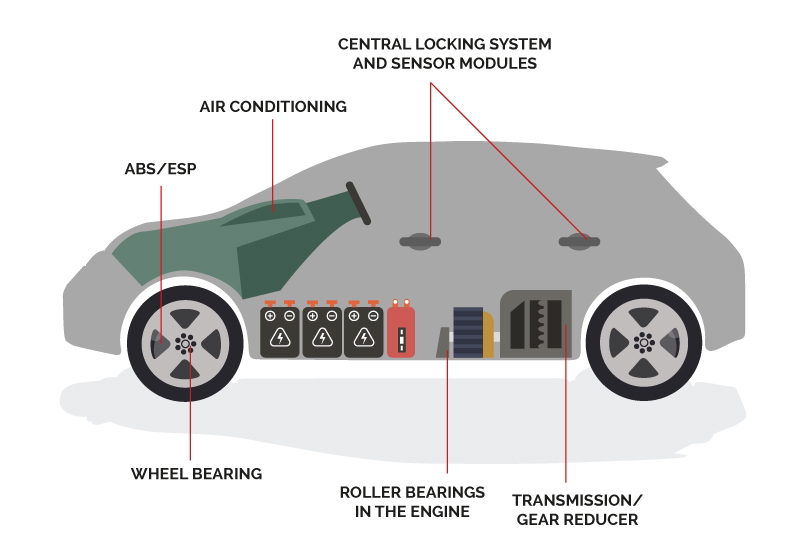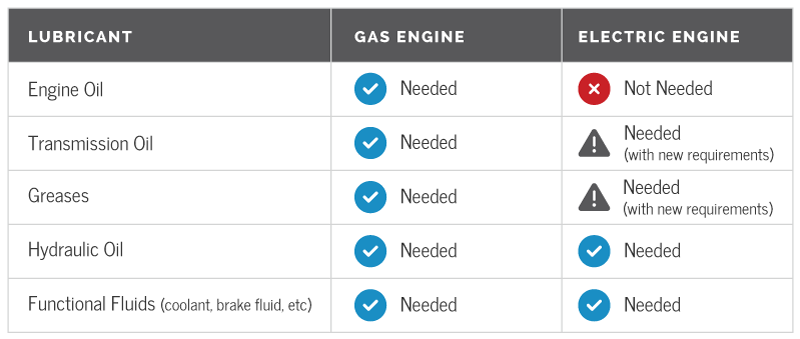The Down and Dirty:
Electric Vehicle Oil and Fluids
Why Going Electric Doesn’t Mean Going Without Oil & Fluids
While some still consider the electric vehicle markets to be in their infancy, research into their batteries and charging systems, cooling methods, drive trains, and even specialized fluids are generating increased excitement around all things electric.
When combined with the rise in fuel and lubricant prices, many may be questioning whether now is the time to switch to electric vehicles (EV) -— and whether doing so means the end of oils and greases. To answer these questions, let’s explore how electric engines work and understand their oil and fluid needs.
What’s the Difference Between EV and Gas Engines?
- Conventional Gas Engines
Conventional engines use combustion to convert gasoline and other fuels into energy, whether in a car, a boat, a tractor, or a string trimmer. As this happens, pistons move up and down in cylinders to rotate a crankshaft and create the power necessary to drive a vehicle or tool. The more fuel or air is fed into the engine, the more power, heat, and exhaust is produced.
Oil and other fluids help regulate temperatures, lubricate moving parts, and prevent degradation. Other systems such as fuel injectors, transmissions, and radiators can also be added to optimize performance. So, how is electric different?
- EV Engines
In contrast to conventional gas engines, the power for modern electric vehicles and tools doesn’t come from combustion. Instead, it converts stored electrical energy from a battery into mechanical energy via a motor.
Electromagnetic fields propel components in the motor to spin rapidly, producing drive. Because this process is near-instantaneous, operators don’t experience the same torque or acceleration delays as conventional gas engines. And as friction is no longer needed to propel the vehicle, the electric motors do not need traditional engine oil. But, electric vehicles continue to require lubrication.
What Lubricants Do EVs Need?
While Electric vehicles don’t use oil in the traditional sense, they do require oils, greases, and functional fluids to prolong their life, regulate temperature, and increase control. Many of these lubricants are subject to new requirements for electric vehicles and are relatively new to the market or are in development.
In electric vehicles, lubricants and fluids are used in these systems:
- Transmissions/Gear reducers
- Central locking and other sensor motors
- Roller bearings
- Air conditioning components
- Wheel bearings
- ABS/ESP
Lubrication Points In An Electric Vehicle

As scientists make new developments, EV fluids and greases will become more specialized to meet the unique challenges of operating in high voltage and extreme temperature settings. These fluids must keep electrostatic charge buildup at a minimum, protect components from corrosion, and insulate high voltage lines from the chassis.
Unlike combustion engine gas vehicles that employ a multi-speed transmission, most EVs utilize a single-speed transmission and gear reducer that is subjected to increased thermal and physical stress at high speeds. A robust, heat-resistant transmission oil will help maintain the optimal performance of electric vehicles.
In addition to the transmission, EV engines, central locking, and motor bearings require lubrication to prolong life, withstand harsh conditions and high temperatures, prevent corrosion, provide oxidation stability, and reduce noise. The compatibility of these greases with various metals such as copper and polymeric cable sheathing is critical.
Battery health is a top priority. Since rapidly charging and discharging batteries produce heat, EV batteries require specialized coolant made of G-48 ethylene glycol and engineered to keep the battery cells between 59 and 95 degrees Fahrenheit.

What Are the Fluid Requirements for Electric Vehicles and Tools?
As research continues into fluids specifically for electric motors and gear reducers (the equivalent of a transmission), it will need to optimize several factors.
- Viscosity at Operating Temperature– Cold environments from 10F to 20F typically call for NLGI 1, and warmer settings call for NLGI 2 or NLGI 3. NLGI has established these ratings for fluid viscosities– no matter the application.
- Fluid Density – The amount of mass per volume of fluid. Important for things like battery coolant, where we want to minimize weight.
- Thermal Conductivity – How easily heat transfers between molecules of fluid. EVs require heat to be removed from the gear reducer without conducting electricity.
- Heat Capacity – A ratio of energy needed per mass to change its temperature. More heat capacity means it absorbs heat better.
- Electric insulation – Depending on your application, additives may be conductive or insulating. Electric engines must be insulated from their surroundings, while some electrical connections require conductive additives.
What Are the Certifications For EV Lubricants?
As EV technology evolves, the need for specialized electric vehicle lubricants will become more essential. If you have questions about EV oils, greases, and fluids, reach out to our team at Pack Logix. With over 70 years of experience working with high-caliber products, we’re recognized as the industry’s quality-driven contract packager of oils, lubricants, greases, fluids, and specialty products.


